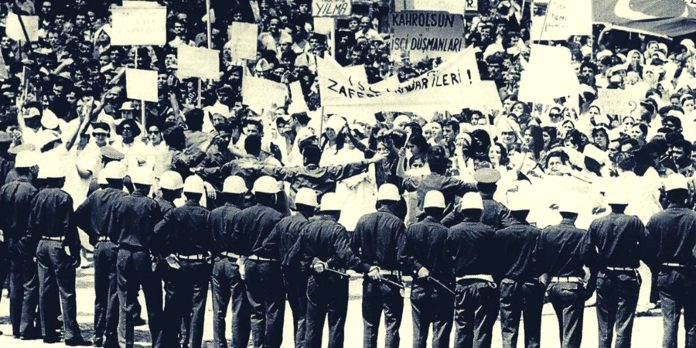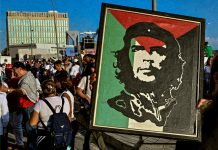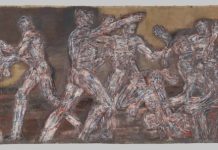The Perspective of Kaldıraç Movement
June 2025 – Kaldıraç Issue 287
The Palace Regime has, for decades, launched ferocious attacks on every act of resistance to demand rights, every attempt by society to breathe, and every action taken by women, youth, and workers. It has mobilized all its forces—its media, courts, judiciary, police, gendarmerie, military, water cannons, tear gas, pepper spray, and batons. In short, it responds with the full weight of its mechanisms to even the smallest act of demanding rights.
In May, workers at TÜPRAŞ, a subsidiary of Koç Holding, who found the collective bargaining agreement insufficient, were met with a police blockade. A mother who lost her son in a train accident was declared a criminal simply for seeking justice at the courthouse doors. Rabia Naz’s father was labeled insane because the trail of his daughter’s murder led to cadres within the AK Party and the state. Those acting to protect nature—such as those protesting against the “Kanal Istanbul” project—have been branded as “terrorists.”
All of this has been ongoing for decades. For decades, the Palace Regime has launched attacks to spread its fear of the future onto the people and the masses.
Despite all these attacks, the social resistance that began with Gezi continues—not with the same high waves as Gezi, of course, but it goes on. The resistance persists despite all repression and violence policies, and despite the state’s practices of civil war.
What truly matters here is not the state’s oppression, but the resistance of the masses. The resistance of women, students, and workers. No matter what they do to suppress or stop this resistance, it continues.
From time to time, these resistances swell with rising waves —like the resistance of the Boğaziçi students or the mobilization on March 19. Yet despite these surges and retreats, the resistance continues to write its own history, expanding, spreading, and taking root.
This line of resistance is fundamental.
Today, the masse, workers, women, and youth are beginning to understand and learn, with increasing clarity, the true nature of the state apparatus and the Palace Regime. Action teaches, resistance sharpens the mind, resistance brings beauty.
The growing resistance nurtures hope. And this hope, in turn, enables the struggle to develop further.
During the mass mobilization on March 19, the masses—led primarily by the youth—voiced a clear message: we do not want to live like this. İmamoğlu’s diploma or his arrest became the last straw. And this mass reaction further developed the line of resistance. For the first time since Gezi, police barricades were breached. And when TÜPRAŞ workers acted as if the police standing in their way didn’t exist and pushed through the barricade, it was a continuation of that same spirit.
During the March 19 mobilization, the state imposed bans, yet the masses took to the streets as if no ban existed. The state labeled them as terrorists, but the crowds were unfazed. Young people were subjected to torture and harassment in police stations and anti-terror branches, yet spirits remained unbroken—the resistance continued even behind bars.
This line of resistance is not only forging a path but also searching for its own leaders.
The question is: How can this line of resistance become more organized, more widespread, and more massive?
There are two main ways to achieve this. First, by building connections between different resistance movements; second, by expanding the resistance even further. Each of these requires organization. They do not happen spontaneously. Yes, there is a spontaneous character in mass actions and resistances. But their advancement, their becoming capable of overthrowing the Palace Regime cannot be realized with this spontaneous character.
Fundamentally, there are three active fronts. Today, the most prominent is the youth movement. The second is the workers’ movement, and the third is the women’s movement. In fact, all of these are part of the broader line of resistance and fall under a single heading.
The development of this whole movement depends on the organization of the revolutionary line of the working class.
And we know that today, the working class not only suffers from a lack of political organization, but perhaps more critically, from a weakness in economic organization as well. Most trade unions are far from being true workers’ unions. Moreover, the vast majority of the working class is not unionized at all. It is still well known that uninsured (informal) labor is widespread. But the main reason for the majority of non-unionized workers is that most unions have ceased to function as genuine worker organizations. The example of Türk Metal, operating like a corporate entity, express the situation very clearly. Anyone seeking to understand the dominant mentality in unionism today can look at Türk Metal, Kamu-Sen, and similar cases to find the answer. Hak-İş and Türk-İş are entirely under the control of a union mafia. Meanwhile, DİSK is far from living up to the “revolutionary” in its name and has strayed far from its own historical roots. Nevertheless, new tendencies are emerging. Even if their power and membership numbers are still limited, ” struggling unions” are beginning to grow. This is of great importance. It may not seem significant when viewed from today’s perspective, but from the future, it will be seen as highly valuable. Another emerging tendency is that as more segments of the working class begin to resist, they are also becoming increasingly aware of the general state of the unions. This too is a critical development.
It is clear that the student movement is undergoing a serious awakening. Issues such as the housing crisis, academic problems, the lack of scientific education, and the transformation of university administrations into extensions of the police state form the objective basis of this awakening. This awakening—this development—is of great importance. The student movement occupies a unique position: it is sensitive to social issues, aware of academic and democratic problems, and in a relatively advantageous place when it comes to taking a stand against all manifestations of bourgeois ideology. There is no doubt, however, that in all three of these areas, a strong foundation is needed. It is therefore evident that the emerging student organizing efforts must move toward centralization in order to be effective.
The struggle, at its core, requires the revolutionary leadership of the working class. And this is only possible through the proletariat’s transformation into a revolutionary force.
Under these conditions, our central task ahead is to develop organization.
This has many dimensions. For example, the development of each revolutionary movement’s own organizational structure is one such dimension. Of course, this does not mean we have the right to dictate how any particular revolutionary organization should operate—everyone knows their own path. This is also our responsibility as a movement. However, the development of the line of resistance has placed a new and different task before all revolutionaries. That task—the task of building organization—now points us toward the formation of a United Front of Labor.
The organization of a United Front of Labor would not only solve the issue of coordinating the entire line of resistance—it is not limited to that task alone. The United Front of Labor is also the path for the development of the revolutionary resistance front.
Breaking the control of the union mafia, reclaiming the unions, and transforming them into genuine workers’ organizations is both a responsibility and a goal for every revolutionary worker. This is not a task limited only to taking a common stance in concrete actions—though that, of course, is extremely important. Being able to develop common positions in every concrete struggle, or even developing ways to do so, is of great value. But the United Front of Labor represents a broader and more comprehensive form of organization.
Sooner or later, workers will be forced to make the dismantling of the union mafia an urgent task on their agenda. In fact, it is already on today’s agenda. On the one hand, it requires the development of “struggling unions”; on the other, it necessitates the emergence of intermediary forms of organization. Moreover, the success of this process depends on the formation of narrow organizations of revolutionary workers in factories and workplaces.
The working class must reconnect with the memory of its past struggles—such as the June 15-16 uprising—not to repeat them, but to learn from them directly and integrate that knowledge into current actions.
Our focus must be fixed on the line of resistance. A perspective limited to observing the internal conflicts within the ruling Palace Regime is not enough. What matters is holding tightly to the struggle and resistance, and correctly evaluating the opportunities that emerge there.
The path to overthrowing the Palace Regime lies within this line of resistance.





